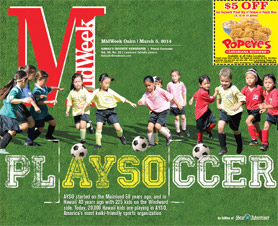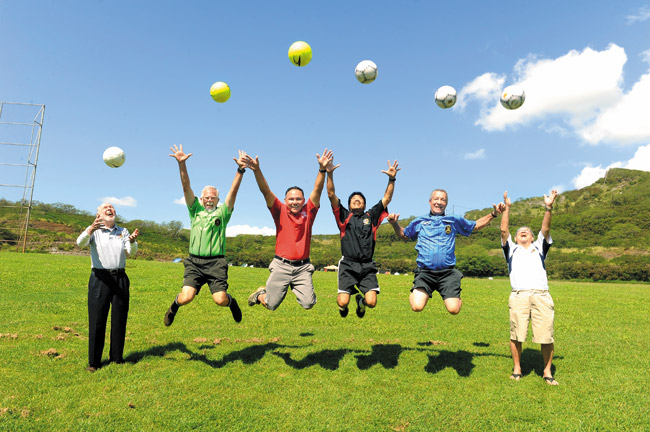PL[AYSO]CCER
AYSO started on the Mainland 50 years ago, and in Hawaii 40 years ago with 225 kids on the Windward side. Today, 20,000 Hawaii kids are playing in AYSO, America’s most keiki-friendly sports organization
When you hear the term “soccer mom,” most of us get a very clear picture in our heads: a harried woman with an SUV full of cleated kids and orange slices with a “PLAYSOCCER” bumper sticker on the back. While it was the Republicans at their national convention in 1996 that brought the term to the public ear, it was American Youth Soccer Organization (AYSO) that created generations of these dutiful mothers.
mw-cover-030514-ayso-1
(from left) 'Mr Soccer' Jack Sullivan, AYSO National Hall of Fame; Scott Reilly, AYSO national referee; Maurice Miranda, director of AYSO Section Seven Hawaii; Geoff Maeda, AYSO Advance coach and coach instructor; Wink Whitaker, AYSO Section VIP coordinator; and Walter Wong, one of the first AYSO Hawaii leaders. Photo by Lawrence Tabudlo
This year marks the 50th anniversary of the organization that taught so many Americans the love of the Beautiful Game, and it began in the most American of ways: in a garage in Southern California. Having started with 100 kids and nine teams, AYSO has grown to become the single biggest soccer entity in the country, with 500,000 kids playing each year. Its focus always has been on doing the most good for the most kids, and it revolutionized the way kids’ sports were run with its “Everyone Plays” and balanced-team philosophies.
“The thing I liked about AYSO is that all the kids get to play a full half,” says Brendan Cravalho, former section director for AYSO in Hawaii. “In baseball, all the kids are only required to play two innings in the field. How are you going to get better that way?”
Their balanced teams do vastly improve the competition within the league. Each year, the players are divided up evenly according to their skills to create competitive balance across entire leagues. Therefore there are no teams full of stars that have played together their whole lives who end up humiliating a group of kids who are just trying to learn.
Here in the Islands, AYSO is celebrating its 40th year in existence. The organization was imported when Peter and Jackie Chaffey moved to Kailua from Torrance, Calif., and wanted their kids to keep experiencing the joy of the game.
“That is what AYSO stands for, family and fun,” says Jack Sullivan, soccer Hall of Fame member who helped the Chaffeys start up the league in Hawaii. “If you want to be competitive and go play for the clubs, that is OK, too, but nearly every soccer player in the state of Hawaii today – I am talking about high school, college, youth and every coach and referee – started in AYSO.”
The first year it had 225 kids playing, all on the Wind-ward side, but the game soon spread west with the trade winds and swelled to more than 1,600 teams with 20,000 kids participating on Hawaii, Maui, Kauai and Oahu.
One of those soccer moms along the way was named Stephanie Whalen. She, like most of the coaches and volunteers, never had played or been involved in soccer, but her 7-year-old son Brian insisted that if he was going to play, she had to coach – and a star was born.
“AYSO was the stepping stone to my entire career, like it is to pretty much every kid who plays soccer,” says Brian Ching, six-time MLS All-Star and three-time Cup champion. “It is where I got my first love for the game. I remember, to this day, her reading the AYSO coaching manual in the car on the way to practice, which I don’t think is the safest thing. It got my whole family into it after that.”
Ching played with AYSO for five years before moving up to club teams to hone the skills that made him the Houston Dynamos’ all-time leading scorer, and while the competition got tougher in other leagues, it was the fervor for the game AYSO instilled in him that carried him on in his career.
“I still have friends who were on my first AYSO team back in Hawaii,” says Ching, who went to school at Kamehameha and college at Gonzaga University. “The pure excitement and joy of running around and playing soccer with my friends is something I’ll never forget. I was always a competitive kid, and I remember crying after every loss. When my mom was coaching me, I remember her having to console me after every game we lost.”
This philosophy of teaching the love of the game first is what has made AYSO so popular with parents and kids alike. There is plenty of time to turn them into professionals, as is witnessed by AYSO products Ching and Olympic gold medalist Natasha Kai.
“Once a child develops a passion for the game, they get better because they want to, because they love to do it,” says Maurice Miranda, section director for Hawaii AYSO. “No matter what the kids decide to do, support them. The more you support the child, the more they want to do it. If you just drop them off at the field and pick them up, they lose interest because you aren’t interested.”
Because it is a 100-percent volunteer organization, it oftentimes gets the parents involved because of necessity, as was the case with Miranda. He signed up his 6-year-old to play AYSO, and in return got a call asking him to coach. Despite having never even played the game, he agreed to do it, and 28 years later he says he simply forgot to quit once his kids aged-out of the league.
“The whole program is volunteers, and I got attracted to it because it was a family-fun environment; it encouraged families to come out and be together,” says Miranda. “The volunteer aspect is the biggest attraction because everyone does it out of a sense of community.”
Having an all-volunteer crew could be a bit of a madhouse except for the infrastructure they have in place. All coaches go through a certification process for the age level they’re coaching, and every volunteer goes through a background check to ensure they’re safe to be with the children.
“There is no need to re-invent the wheel when you come to AYSO,” says Miranda. “We certify each coach so that no one has to wing it.”
Perhaps the best example of the closeness parents feel to the organization can be seen in the memorial made by former player Kirk Banks’ parents. He was out jogging one day in Kailua, and was struck by a car and killed. To honor his memory, they donated money to AYSO to commemorate him and help further his favorite sport’s growth in the Islands.
The Kirk Banks tournament now is going on its fourth decade in existence and held during spring break, as teams from across the state come together at Waipio Soccer Complex to compete for medals in his honor.
While the kids enjoy winning medals and dream about scoring goals for their country like Ching and Kai, it all still comes down to a love of the game for the AYSO organizers.
“We have the most kids of any sport activity, and I think it is because we are a family-oriented activity. We are not trying to professionalize our youths,” says Miranda, who lives on Hawaii Island. “There are exuberant parents who want their kid to be the next Michael Jordan or Shane Victorino, and parents putting all their resources into it making sure their 7-year-old is going to be the next star.
“At AYSO, it is all about letting the kids be kids, letting them enjoy it and do something physical.”







